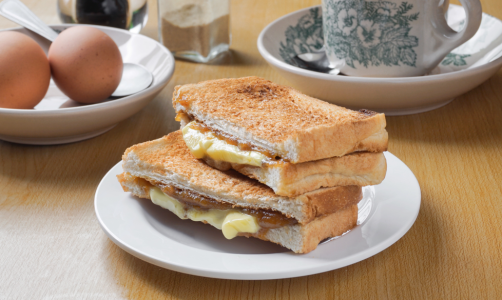Prices Are Exploding! Are You Prepared to Give Up This Essential Australian Grocery Item?
By
Gian T
- Replies 22
In the land down under, where Vegemite, Tim Tams, and a good old 'Barbie' are staples of our culinary culture, there's another beloved item that's been quietly slipping out of our shopping baskets due to its soaring cost. It's the humble block of butter, once a non-negotiable grocery list item for many Australian households. But as prices continue to climb, many of us are left wondering whether we can still afford this creamy delight.
Butter has long been a versatile kitchen staple, making its way into our sandwiches, pastries, and sauces and adding that rich, indulgent flavour we all know and love. Whether it's the secret to your flaky pie crust or the finishing touch on your morning toast, butter holds a special place in our hearts—and our recipes.
However, recent data has revealed a hard truth: the days of thoughtlessly tossing a pack of butter into our trolleys are fading away. The price of butter has skyrocketed, and it's not just the wallets of keto dieters—who swap carbs for fats—that are feeling the pinch. Every Australian who enjoys the luxury of butter is noticing the hit to their grocery bill.
A 500g pack of butter, once modestly priced, can now cost between $8 to $10, and that's just your standard variety. If you're someone who prefers the organic, single-origin types, you're looking at an even steeper price tag. The fats and oils category, which includes butter, is one of the fastest-rising categories in the supermarket, and it's not hard to see why.
You might be scratching your head, wondering why butter prices are churning upwards when cows are still producing milk, and we're even making more butter than before. According to Dairy Australia, we've seen a 3% increase in milk production and an 8% increase in butter production in the 2023-24 period compared to the previous year. So, what's causing the price hike?
The answer lies in the global market. Australia has resumed exporting butter after a period of reduced overseas sales, and the demand is high. The global price for butter has risen, and it's not just Australians who are feeling the financial heat—this is a worldwide trend. The Dairy Trade auction, a global event that occurs every few weeks, has seen unusually high prices bid for butter, indicating a surge in demand.
Europe, with its high butter consumption—especially in France, where the average person reportedly consumes around 8kg of butter per year—is also experiencing skyrocketing prices. The root of this global price increase can be traced back to the aftermath of lockdowns and the ongoing conflict in Ukraine, which initially affected prices of commodities like wheat and meat and has now spread to dairy.
Additionally, the cheese industry's record demand has diverted much of the milk supply away from butter production, leading to a 'butter spike.' And if that wasn't enough, the dairy industry is also grappling with the impact of cow flu. The H5N1 strain of bird flu has affected dairy cows in the United States, leading to concerns about another virus crossing from animals to humans and causing disruptions in milk production.
With all these factors at play, it's no wonder that butter prices are melting our budgets. As the canola fields bloom, farmers may be anticipating a rise in demand for their crops as an alternative to butter, potentially leading to a surge in margarine prices next.
 We'd love to hear from you. How has the rising cost of butter affected your grocery shopping? Have you found any savvy substitutes or strategies to cope with the price hike? Share your thoughts and tips in the comments below, and let's navigate these buttery waters together.
We'd love to hear from you. How has the rising cost of butter affected your grocery shopping? Have you found any savvy substitutes or strategies to cope with the price hike? Share your thoughts and tips in the comments below, and let's navigate these buttery waters together.
Butter has long been a versatile kitchen staple, making its way into our sandwiches, pastries, and sauces and adding that rich, indulgent flavour we all know and love. Whether it's the secret to your flaky pie crust or the finishing touch on your morning toast, butter holds a special place in our hearts—and our recipes.
However, recent data has revealed a hard truth: the days of thoughtlessly tossing a pack of butter into our trolleys are fading away. The price of butter has skyrocketed, and it's not just the wallets of keto dieters—who swap carbs for fats—that are feeling the pinch. Every Australian who enjoys the luxury of butter is noticing the hit to their grocery bill.
A 500g pack of butter, once modestly priced, can now cost between $8 to $10, and that's just your standard variety. If you're someone who prefers the organic, single-origin types, you're looking at an even steeper price tag. The fats and oils category, which includes butter, is one of the fastest-rising categories in the supermarket, and it's not hard to see why.
You might be scratching your head, wondering why butter prices are churning upwards when cows are still producing milk, and we're even making more butter than before. According to Dairy Australia, we've seen a 3% increase in milk production and an 8% increase in butter production in the 2023-24 period compared to the previous year. So, what's causing the price hike?
The answer lies in the global market. Australia has resumed exporting butter after a period of reduced overseas sales, and the demand is high. The global price for butter has risen, and it's not just Australians who are feeling the financial heat—this is a worldwide trend. The Dairy Trade auction, a global event that occurs every few weeks, has seen unusually high prices bid for butter, indicating a surge in demand.
Europe, with its high butter consumption—especially in France, where the average person reportedly consumes around 8kg of butter per year—is also experiencing skyrocketing prices. The root of this global price increase can be traced back to the aftermath of lockdowns and the ongoing conflict in Ukraine, which initially affected prices of commodities like wheat and meat and has now spread to dairy.
Additionally, the cheese industry's record demand has diverted much of the milk supply away from butter production, leading to a 'butter spike.' And if that wasn't enough, the dairy industry is also grappling with the impact of cow flu. The H5N1 strain of bird flu has affected dairy cows in the United States, leading to concerns about another virus crossing from animals to humans and causing disruptions in milk production.
With all these factors at play, it's no wonder that butter prices are melting our budgets. As the canola fields bloom, farmers may be anticipating a rise in demand for their crops as an alternative to butter, potentially leading to a surge in margarine prices next.
So, dear members of the Seniors Discount Club, what does this mean for our shopping habits? Are we to bid farewell to our beloved butter, or will we tighten our belts elsewhere to keep this golden treasure on our tables? It's time to explore alternatives or to cherish every last pat of butter a little more.
Key Takeaways
- The price of butter in Australia has increased significantly, causing concerns among consumers.
- Rising global dairy prices and a return to exporting butter have increased domestic costs.
- Factors such as global food price spikes post-lockdowns, demand for cheese affecting milk availability, and the bird flu impacting dairy cows are influencing the market.
- The fats and oils category, which includes butter, is one of the fastest-rising categories in the supermarket, with consumers feeling the pinch in their grocery bills.








